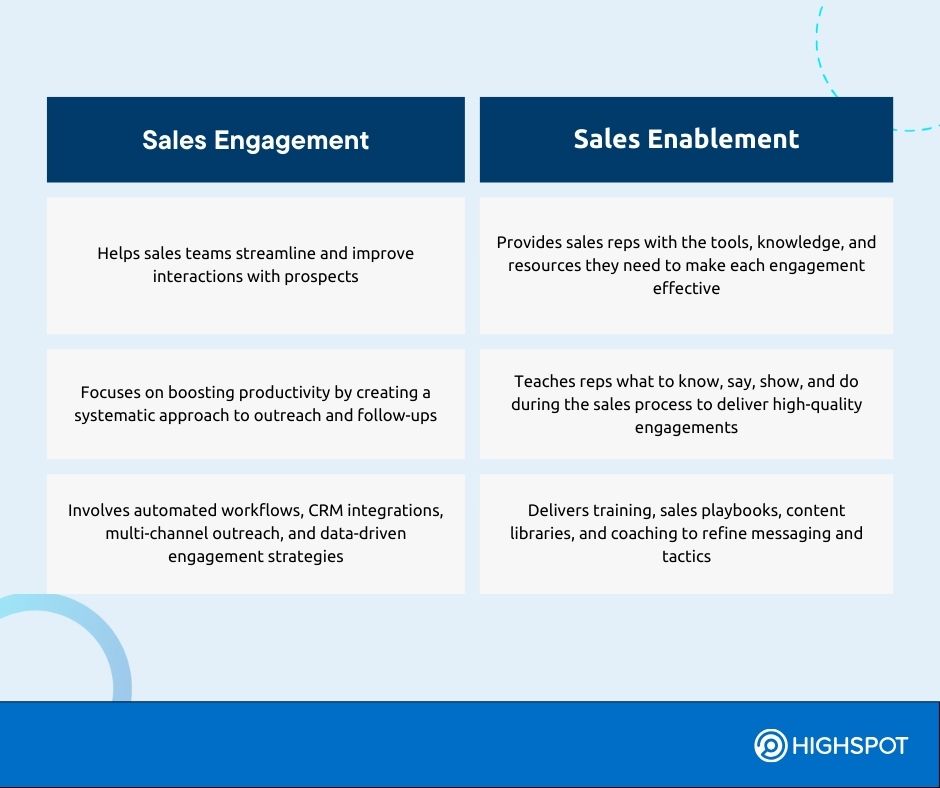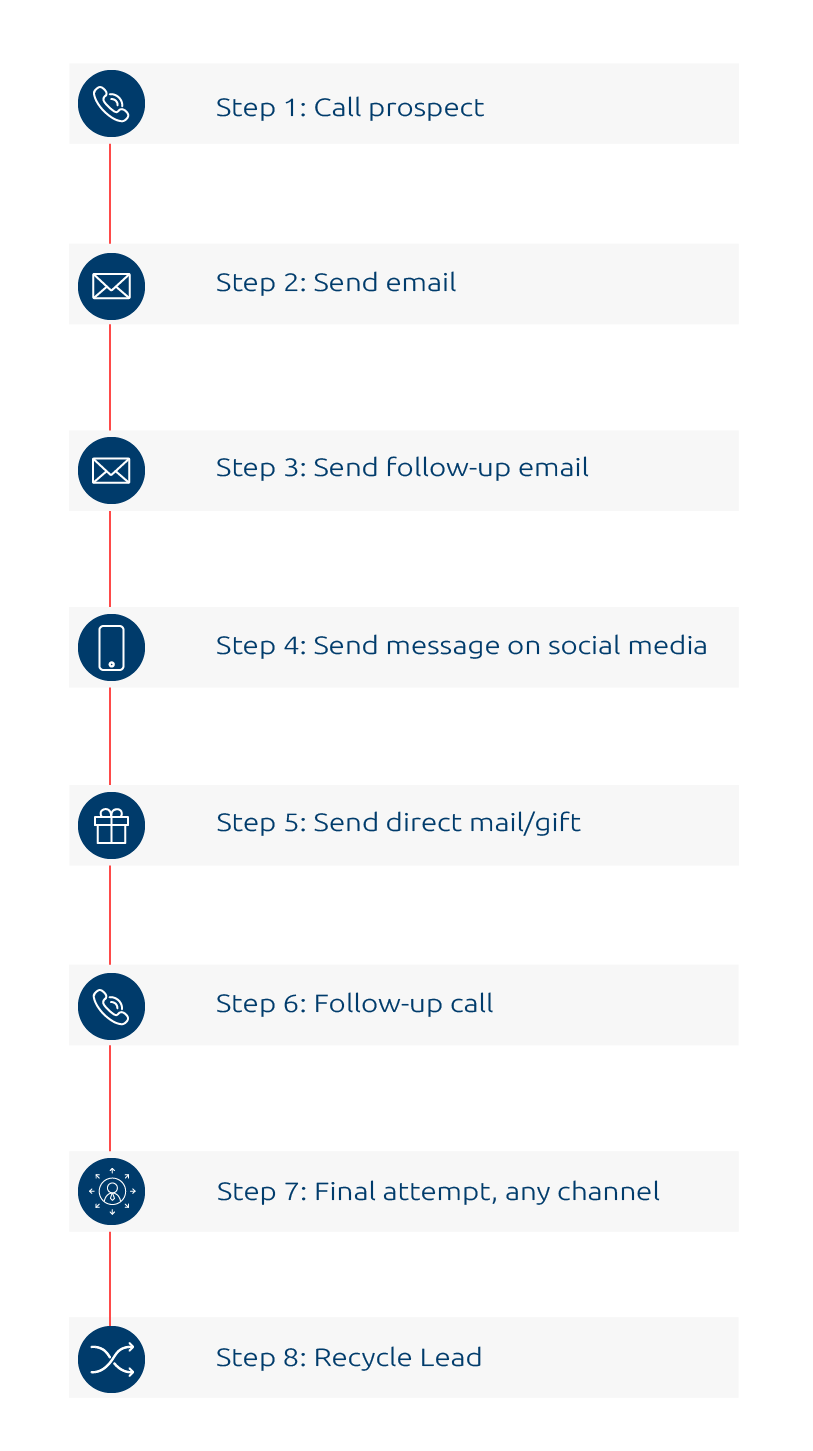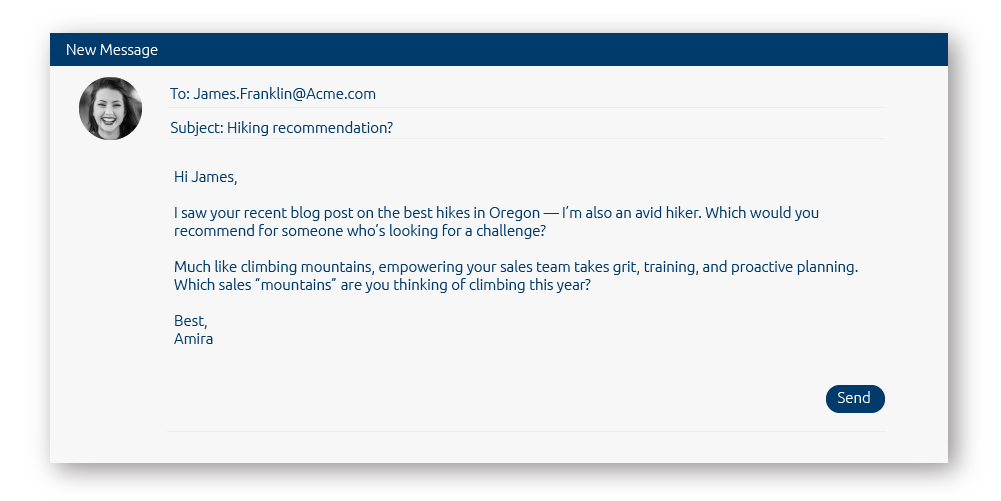Key Takeaways
- Sales engagement covers all the interactions between a sales rep and a prospect during the sales process.
- When sales reps improve their interactions with prospects, they can build stronger relationships and guide buyers toward making a purchase.
- The right tools and data make tracking progress and improving your engagement strategy easier.
Connecting with prospects is key to securing new business. But standing out to prospects in our cluttered digital sales landscape is difficult. How can salespeople cut through the noise and drive impactful engagements with prospects across all touchpoints?
The answer lies with your sales engagement strategy. Done right, it will ensure that your sellers know how and when to reach customers, leaving no prospect behind.
In this guide, we’ll break down what makes a sales engagement strategy shine.
What Is Sales Engagement?
Sales engagement refers to all the interactions that take place between a salesperson and a prospect throughout the sales cycle. Today, most interactions take place on calls or online via email or social media, allowing sales organisations to build scalable, multichannel engagement strategies that accelerate revenue growth.
Here’s how it works: Rather than letting salespeople randomly determine how and when to engage customers, sales managers can use data to build a formalised framework that tells salespeople how and when to engage with buyers. This ensures that buyers receive the right information at the right stage of their buyer’s journey and that salespeople keep deals moving forward.
Sales engagement takes many forms. Whether it’s an email you sent, a call you had, or a post on social media, they all take the form of sales engagement. Now, you may not need a dedicated sales engagement software or platform to engage with prospects, but it will help you streamline your efficiency and sales outreach. More on that in a bit.
Why Sales Engagement Matters
At its core, sales engagement fosters meaningful connections with potential and existing customers. This process is crucial because it goes beyond the transactional aspects of selling and focuses on building relationships.
By actively engaging with customers, sales teams gain valuable insights into their needs, preferences, and challenges. This understanding allows sales professionals to tailor their approach, offering solutions that resonate with customers on a personal level. Effective sales engagement not only drives conversions but also contributes to customer retention and loyalty. Companies that successfully engage customers perform 23% better than their competitors, report 63% lower customer attrition, and achieve 55% higher wallet share.
Sales engagement also helps speed up your onboarding and training for the sales team. By seeing which sequences work best for your target market, you can train your team on the most effective practices.
Sales Engagement vs. Sales Enablement
Though they may sound similar, sales engagement and sales enablement focus on two separate aspects of rep productivity.

Sales engagement is centered on efficiency: most engagement strategies accelerate a rep’s output through a systematic approach to buyer engagement.
Sales enablement, on the other hand, is focused on effectiveness. Sales enablement seeks to ensure that every engagement is impactful by empowering teams with knowledge of what to know, say, show, and do.
Together, sales enablement and sales engagement help scale your sales processes to ensure that every rep, from your SDRs to your account managers, knows exactly how to maximise every customer interaction across the buyer’s journey.
What Is Prospect Engagement?
Prospect engagement is a subset of sales engagement, focused on the early stages of the buyer’s journey. When engaging a prospect, salespeople more than ever need to capture and keep buyer attention. Doing so can be achieved with a tested, formalised approach to engaging buyers.
Your exact approach will vary depending on your business. In fast-paced SaaS selling environments, for example, this may mean rapid, frequent communication with buyers across many channels. For more traditional industries, like financial services, engaging prospects might require a slower approach over a longer sales cycle.
Ultimately, tailoring your prospect engagement strategy to your buyers will be key to driving impact.
What Is a Sales Engagement Platform?
A sales engagement platform is an essential part of your engagement strategy. It allows you to scale your approach to prospect engagement by guiding rep activities throughout the customer journey.
With the addition of sales engagement tools, you can quickly map out a path for effective engagement across email, direct mail, phone, social media, and other communication channels. Operating through a platform ensures that the impact of these activities is tracked, allowing businesses to use data to drive decisions around their overall sales strategy.
A good sales engagement platform typically has the following functionality:
- Integrated Workflows: These features connect your tools and platforms to unify workflows, personalise interactions, and scale your customer engagement strategy.
- Sales email/call sequencing
- Email scheduling
- Outreach templates
- CMS/Email integrations
- Social media integration
- Analytics: These features are critical to understanding how your reps and your business perform.
- Open rates/views
- Content engagement activity
- Rep activity
- Calling: These features streamline communication with prospects and boost rep productivity.
- Call types
- Click-to-call dialers
- Call scripts and templates
- Contacts: These features ensure reps can make smart decisions regarding account-based selling.
- Prospect data management
- Account-based selling support
- Lead scoring
- Content Management: These features allow easy access to relevant resources, helping sales representatives engage prospects more effectively.
- Content libraries
- Version control
- Content usage analytics
- Communications and Conversational Intelligence: These features centralise emails, phone calls, and social interactions in one platform to track prospects and manage their outreach. Some tools leverage conversation intelligence, which suggests real-time responses and provides post-call feedback to improve sales outcomes.
- Automated transcripts
- Call analysis
- Real-time coaching
- Digital sales rooms
A word of caution, however — a sales engagement platform can make it easy to bombard customers with automated emails and enquiries. Be sure your engagement approach up-levels interactions without overwhelming buyers.
Types of Sales Engagement Platforms
Outreach: Primarily focused on providing sales engagement automation. It streamlines communication and outreach efforts, allowing sales teams to efficiently connect with prospects and customers.
SalesLoft: Designed to provide a comprehensive set of tools for sales engagement, combining automation, communication, and analytics to optimise sales workflows. See how SalesLoft integrates with sales enablement platform, Highspot, to bring more personalisation to the buyer’s journey.
Salesforce Sales Cloud: Primarily a CRM platform with a strong emphasis on sales engagement. It provides a centralised hub for managing customer relationships, leads, and sales activities.
Benefits of Using a Sales Engagement Platform
Sales teams are under constant pressure to engage with prospects, nurture relationships, and close deals while managing an overwhelming amount of data. A sales engagement platform can solve these challenges by centralising key tools and automating manual tasks. In turn, sales reps can focus on what they do best, while managers can get the insights they need to make data-driven decisions. It’s among the highest ROI technologies a company can invest in, with 92% of sales development organisations considering this tool crucial to their success.
Let’s explore the benefits of a sales engagement platform:
1. Improve Efficiency
Surprisingly, sales reps spend only 28% of their week selling. Most of the time, they are bogged down by other tasks like data entry and deal management. A sales engagement platform can do the heavy lifting by automating repetitive tasks that take up a lot of a sales rep’s time so that they can focus on high-value activities like generating leads and engaging with prospects.
2. Deliver More Personalised Messaging
Sales engagement software helps sales reps tailor their messages to each prospect based on their needs, interests, and behaviours. It can segment audiences so reps can send personalised emails, schedule calls at optimal times, and follow up more naturally and relevantly. AI enhances this process by analysing past interactions and recommending the most effective messaging, content, and timing.
3. Simplify Your Sales Strategy
A sales engagement platform brings all your tools and processes in one place, making it easier for teams to align on a unified sales strategy. It helps you determine how to reach potential buyers and move them through the sales pipeline. With well-coordinated outreach, you can close deals faster and enhance customer experience.
4. Enhance Sales Processses
Sales engagement tools simplify sales reps’ day-to-day tasks, but their true value lies in helping them work smarter. They provide reps with data from every interaction so they can determine the most effective ways to connect with customers. That’s what makes these tools so valuable—they optimise and bring out the best in every sales process.
5. Track and Analyse Interactions
Sales engagement platforms provide insights into what’s working and what isn’t, whether it’s how your prospect responds to calls or what kind of feedback you’re getting in meetings. This helps you understand buyer behaviour, refine your messaging, and improve your outreach strategies to boost engagement.
Best Practices for Effectively Engaging Prospects
Now that you have an understanding of what sales engagement is and why it matters, it’s time to start building your sales engagement strategy. Use the tips below to create an impactful programme that accelerates sales and grows your business.
1. Create a Content Strategy
Developing a compelling content strategy is key to engaging buyers and guiding them through their journey. Today’s buyers expect value at every stage, whether it’s a case study that tackles their challenges or a demo video that showcases your product in action. By aligning your sales collaterals with the buyer’s journey, you can provide relevant, educational materials that address their concerns and answer their questions at the right time.
2. Align with Marketing
Much of your engagement strategy will be supported by marketing-created content. These are the assets that your salespeople will send via social media or email. Therefore, it’s essential that you have sales and marketing alignment to ensure that you have visibility into what’s being created, but also that it supports your team’s needs.
The easiest way to do this is by setting up a recurring meeting where marketing reviews their upcoming content strategy and editorial calendar. This will ensure you can offer timely feedback and prepare your teams to make the most of this content when it launches.
Related resource: Best Practices for Sales and Marketing
3. Invest in Technology
As with any element of your sales strategy, the right tools make it much easier to achieve your goals. To effectively implement your sales engagement strategy at scale, investing in many tools like a CRM, as well as a sales engagement and a sales enablement platform is important.
A sales engagement platform will allow you to rapidly build, optimise, and analyse your sales engagement strategy. A sales enablement platform, on the other hand, will ensure your reps have the content, training, and guidance they need to respond to buyers effectively. A CRM will give you insights into real-time engagement and activity with your leads.
Automation further enhances this ecosystem by streamlining repetitive tasks like email follow-ups, lead nurturing, data tracking, and managing sales cadences. In turn, sales reps can focus their time and energy on building relationships and closing deals.
4. Use a Multi-Channel Approach
How often do you stick to just one way of communicating? Probably not often, and the same goes for your buyers. Using a mix of channels helps you meet prospects where they’re most comfortable.
Each channel has its sweet spot. Emails and digital sales rooms are great for sharing detailed information, phone calls and in-person interactions help you connect on a personal level, and social media and SMS offer a more casual way to engage. This combination of channels allows you to meet buyers where they are and create more opportunities to connect and build meaningful relationships.
An effective sales engagement campaign will accelerate sales by providing an outreach framework to guide salespeople throughout the sales process. Just look at the example sales sequence below.

These sequences can be built to guide salespeople through any sales process: first sale, renewal, upselling, and cross-selling.
But be sure to emphasise that these frameworks, especially if automated, are just that — frameworks. As salespeople engage with buyers, it’s important to monitor their response. If a lead expresses negative sentiments at any stage, it’s better to back off and save the relationship than push through with the sequence.
5. Personalise Everything
With powerful technology also comes great responsibility: The ability to automate workflows can tempt salespeople to send flurries of templated emails. But this is a sure path to failure — buyers not only want but expect personalised communications and insights from salespeople.
Ensure your teams don’t make this mistake by building space for personalisation into email templates. A simple solution is to include “{Personalise}” as a reminder at the beginning of templates, after the greeting.
Beyond templates, reinforce the importance of personalisation through coaching sessions, sales plays, and team syncs. Whether it’s through emails, calls, or meetings, showing a genuine understanding of a buyer’s pain points positions your product or service as a solution designed just for them, creating a stronger connection and better customer service.
6. Make the Most of Sales Enablement and Playbooks
Sales enablement plays a key role in the success of your engagement strategies. It should be your go-to for creating and using sales playbooks that guide your team. These playbooks should cover the essentials: best practices, ways to handle objections, pricing strategies, and key messaging points. Having a well-defined playbook empowers team members to navigate sales conversations more effectively and consistently.
7. Continuously Optimise
The work doesn’t end once you’ve launched your sales engagement strategy: Once reps have adopted your sequences and are using the required platforms to engage buyers, your mindset should shift from “launch” to “optimise.”
This requires diving deep into your sales engagement and enablement platform analytics. Look at both high-level metrics – such as cumulative open rates, view times, conversion rates, or number of SQLs – as well as individual-level performance metrics. This will help you understand the impact of your sales engagement strategies and identify opportunities to support poor performers.
8. Get Creative
Finally, every sales engagement strategy should leave room for fun. Buyers are human, after all, and a hyper-personal outreach effort can make the difference between a recycled lead and a won deal.
Lean into creative engagement approaches, such as sending personalised gear, or gift cards to local coffee shops or restaurants. Creative touches don’t have to be purely monetary either – a fun reference to a pop culture moment or something a buyer shared on LinkedIn can also be effective, like the example below.

Grow Your Business with Sales Engagement
With the right sales engagement strategy and tools in place, you can ensure that every sales rep is maximising their performance and moving your business forward.
Strengthen your sales engagement strategy with Highspot, the world’s leading sales enablement platform. Highspot integrates with some of your most favourite tools to bring more personalisation and efficiency to the sales process.
This post was originally published in November 2020 and has been updated for accuracy and comprehensiveness.




